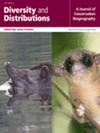Divergent Importance and Geographic Patterns in Threats to Birds and Mammals in China
Abstract
Aim
Wildlife populations are continuing to decrease worldwide. Understanding the ranking and distribution of drivers of species declines is crucial to enable targeted actions to counteract major threats. However, few studies have assessed the relative importance and geographic distribution of threats to biodiversity in China, even for high-profile groups such as birds and mammals. Therefore, this study aims to rank and map the distribution of threat to birds and mammals in China, which could provide novel insight into biodiversity conservation in China.
Location
China.
Methods
A database of different threats for 147 threatened bird species and 176 threatened terrestrial mammal species was obtained from China's Red List of Biodiversity published in 2021. We collated information on the distribution and threat categories for birds and mammals in China, aiming to classify, rank and map threats. We used Bray–Curtis dissimilarity index to examine the correlations of threats occurring simultaneously, and compared the distribution of habitat of threatened birds and mammals. In addition, we conducted threat ranking analyses of threatened birds and mammals between different orders and traits (body mass and clutch/litter sizes).
Results
The results showed that the most common threats to birds were habitat loss, hunting, human disturbance, agriculture, pollution and logging, while the most common threats to mammals were hunting, agriculture, logging, habitat loss, human disturbance and livestock farming or ranching. These threats showed different geographic patterns, and some threats frequently co-occur as threat syndromes. Forests were the primary habitat for most threatened species, and orders formed by larger species with small clutch or litter sizes were more likely to be threatened.
Main Conclusions
We highlight the most common threats and key areas for conservation. Furthermore, focusing on clusters of co-occurring threats may be the most effective way to aid recovery of threatened species, and targeted actions are needed to counter ongoing population declines in many groups. These actions should not be limited to the protection of regions where species are at risk of multiple significant threats, but should also include the maintenance and restoration of native forests and strategic planning of afforestation through planted forests.


 求助内容:
求助内容: 应助结果提醒方式:
应助结果提醒方式:


